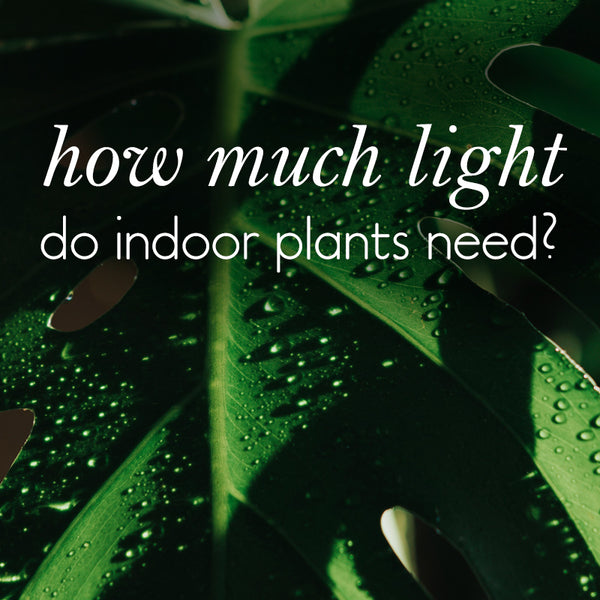What light levels do indoor plants require?
This one's a toughie. It may seem like every plant care guide says "bright, indirect light" but different indoor plants have a different range of light they can handle and still be happy.

At one end there's the 'Minimum for Maintenance' where your jungle members may stay alive, but may not do much in the way of grow. At the other end there's 'Commercial Growth' light levels that a grower might use to achieve maximum growth, getting plants ready for sale sooner.
In the middle is the 'Good Growth' level. That's the level us indoor plant hobbyists want to aim for (sometimes the help of a grow light is needed). The Plant Species Light Guide below, includes some of the most popular houseplants and the light levels they require to make it easier to find the best 'happy place' at your place for your plants to thrive.
How to read the Plant Species Light Guide
The first set of numbers on the left is the Minimum for Maintenance (MM). The middle set of numbers achieves Good Growth (GG), and the third set of numbers is for Commercial Growth (CG).
Plants with a higher Minimum Maintenance level (the first set of numbers), are more likely to require a grow light when grown indoors, unless you can give them plenty of bright light for 12+ hours a day.
If the Minimum for Maintenance is low, this indicates the species is more low-light tolerant. If the Commercial Growth level is low, this indicates a species than won't tolerate very bright light or direct light well.
For most indoor settings, aim for at least the Good Growth level. To maintain a Commercial Growth level of light requires a more controlled setting such as a greenhouse, along with control over and close maintenance of other factors such as soil pH, airflow, temperature, humidity and fertiliser.
Ideally you'll need a good light meter to test the light levels, however this chart is still super helpful to find out how tolerant of low light your plant is, and how much 'indirect, bright light' they really need.
You'll see FC and µmol after each set of numbers. FC stands for Foot Candle and µmol is the symbol for a micromole, used to count the number of photons in a plant grow light system. Note that FC varies based on the type of light source.
The chart below is based on sunlight requirements. Also keep in mind this guide gives you the average requirements per species. There will be individual varieties within each species that may fall outside of these averages.
The Plant Species Light Guide
KEY: See above first for how to read and use this guide
African Violet
200 FC (40 µmol) | 400 FC (80 µmol) | 1000 to 1200 (200-240 µmol)
Alocasia
200 FC (40 µmol) | 400 FC (80 µmol) | 2000 to 5000 (400-1000 µmol)
Anthurium
100 (20 µmol) | 400 (80 µmol) | 1500 to 2000 (300-400 µmol)
Begonia
200 FC (40 µmol) | 400 FC (80 µmol) | 2000 to 2500 (400-500 µmol)
Calathea
200 FC (40 µmol) | 400 FC (80 µmol) | 1000 to 1200 (200-240 µmol)
Hoya
100 (20 µmol) | 400 (80 µmol) | 1500 to 2500 (300-500 µmol)
Ficus
400 (80 µmol) | 800 (160 µmol) | 2000 to 6000 (400-1200 µmol)
Syngonium
100 (20 µmol) | 200 (40 µmol) | 1500 to 3000 (300-600 µmol)
Monstera
100 (20 µmol) | 400 (80 µmol) | 1000 to 2500 (240-500 µmol)
Peace Lily
50 (10 µmol) | 200 (40 µmol) | 1500 to 2500 (300-500 µmol)
Peperomia
100 (20 µmol) | 200 (40 µmol) | 1500 to 3000 (300-600 µmol)
Phalaenopsis
200 FC (40 µmol) | 400 FC (80 µmol) | 1000 to 1500 (200-3000 µmol)
Philodendron (vining, eg: Heartleaf, Brasil)
100 (20 µmol) | 200 (40 µmol) | 1500 to 3000 (300-600 µmol)
Philodendron (climbing, eg: Pink Princess)
200 FC (40 µmol) | 400 FC (80 µmol) | 1500 to 2500 (300-500 µmol)
Pothos (Epipremnum, Scindapsus)
100 (20 µmol) | 200 (40 µmol) | 3000 to 5000 (600-1000 µmol)
Sansevieria
100 (20 µmol) | 200 (40 µmol) | 1000 to 6000 (200-1000 µmol)
ZZ Plant
100 (20 µmol) | 200 (40 µmol) | 1000 to 2000 (200-400 µmol)
Because the subject of light, and grow lights, can start off super confusing, I've created the Ultimate Guide to Grow Lights > to help simplify everything to do with grow lights.
Keep learning...

